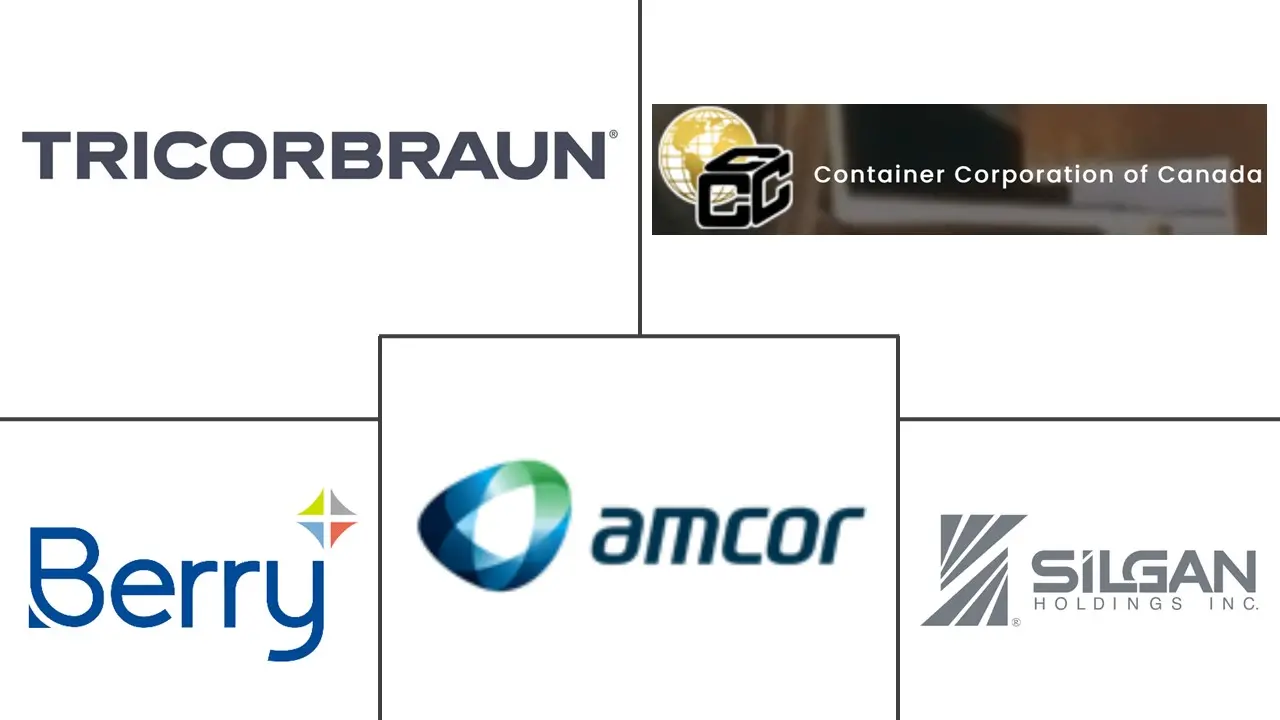Canada Plastic Bottles Market Size and Share
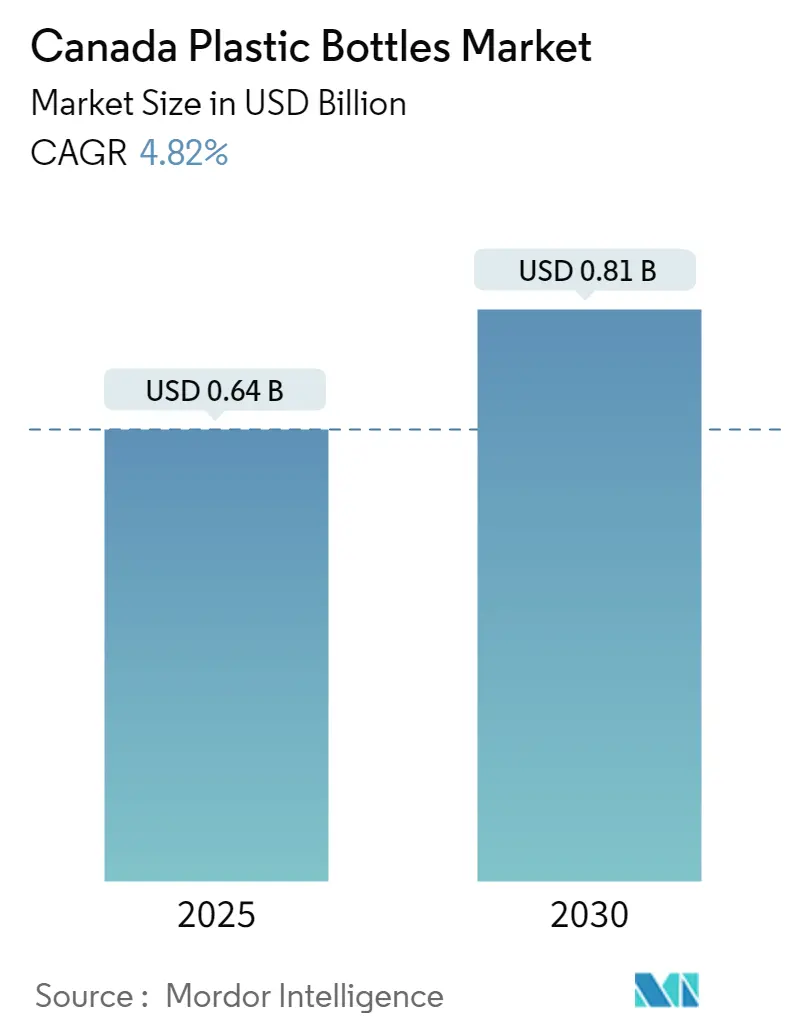
Canada Plastic Bottles Market Analysis by Mordor Intelligence
The Canada Plastic Bottles Market size is worth USD 0.64 Billion in 2025, growing at an 4.82% CAGR and is forecast to hit USD 0.81 Billion by 2030.
The growing demand for plastic bottle solutions and the swift adoption of plastic packaging techniques across diverse industries significantly boost the market’s growth.
- Plastic bottles are known for their robustness and adaptability and are recognized as food-safe by the Canadian Food Inspection Agency (CFIA). These plastics find applications across various FMCG sectors, including food, beverages, pharmaceuticals, etc. Their versatility extends to industries like cosmetics, paving the way for market expansion.
- Local industries spanning pharmaceuticals, food, and beverages are increasingly using plastic packaging solutions. Strong barrier qualities, extended shelf life, and durability have garnered significant traction, especially in the Canadian food and beverage sector, which may boost the demand for plastic bottles in the future.
- Efforts are underway to develop technologies that ensure barrier materials align seamlessly with established recycling procedures and quality standards. Resin businesses are actively addressing these challenges. While many products were traditionally single-use bottles, several companies are focusing on integrating recycled plastics to ease consumer concerns. Innovations are emerging, such as harnessing plastics recycled through non-mechanical methods like chemical recycling, which could significantly reduce the reliance on single-use plastic packaging.
- According to the Canadian Energy Centre, in April 2024, the Paris-based Organisation for Economic Co-operation and Development (OECD) published the Global Plastics Outlook, projecting that global plastic usage will nearly triple by 2060, spurred by economic and population growth. OECD countries, including Canada and various nations, are also expected to see a doubling in plastic usage. The management at the Chemical Industry Association of Canada (CIAC), which advocates for Canada's plastics producers, stated that the demand for plastics highlighted their integral role in daily life, spanning packaging, industries, and equipment. Such projections are expected to push the demand for plastic bottles across the country.
- According to the Canadian government, people discard over 3 million tonnes of plastic waste every year. A mere 9% of this is recycled; the remainder finds its way into landfills, waste-to-energy facilities, or the environment. This plastic waste and marine litter burden the economy and jeopardize the environment's health, impacting wildlife, rivers, lakes, and oceans. However, swiftly curbing plastic waste and pollution can bolster the economy, helping make significant strides in safeguarding wildlife and cherished natural spaces.
Canada Plastic Bottles Market Trends and Insights
The Polyethylene Segment is Expected to Record Growth
- Polyethene is a lightweight, partially crystalline, thermoplastic resin with high chemical resistance, low moisture absorption, and sound-insulating properties. It is used for packaging plastic bottles.
- HDPE and LDPE are formed through the polymerization of polyethylene. During this process, monomers link together to create elongated hydrocarbon chains. These chains then branch out in various directions, with the branching pattern determining the material's strength and density. HDPE and LDPE vary in thickness, making HDPE ideal for strength-focused applications, while LDPE proves more advantageous for making bottles.
- Plastic bottles have significant applications in consumer products, such as food, beverages, and cosmetics. The growing need for plastic bottles can be attributed to the rising packaging solutions that are convenient and portable. The ever-increasing urban lifestyle of consumers in the region also drives the demand for convenient packaging.
- Consumers are looking for easy-to-use and lightweight packaging. Vendors are designing innovative packaging solutions to remain competitive in the growing organized retail market and meet changing demands. According to StatCan, the monthly retail trade in Canada in December 2023 was CAD 66.95 billion (USD 49.59 billion), up from CAD 66.41 billion (USD 49.19 billion) in September 2023.
- In November 2023, Dow Chemical Company announced that its management had given the green light for its Fort Saskatchewan Path2Zero initiative. This project aimed to establish the world's first integrated ethylene cracker and derivatives facility in Alberta, Canada, achieving net-zero Scope 1 and 2 emissions. With a price tag of USD 6.5 billion, not accounting for governmental incentives and subsidies, the project encompasses the construction of a new ethylene cracker and auguring polyethylene capacity by 2 million MTA. Further, the growing demand for plastic bottles, in line with the move to single-person living, drives growth in convenience store retailing, boosting the demand for more convenient packaging solutions. Such expansions are expected to create opportunities for the polyethylene segment.
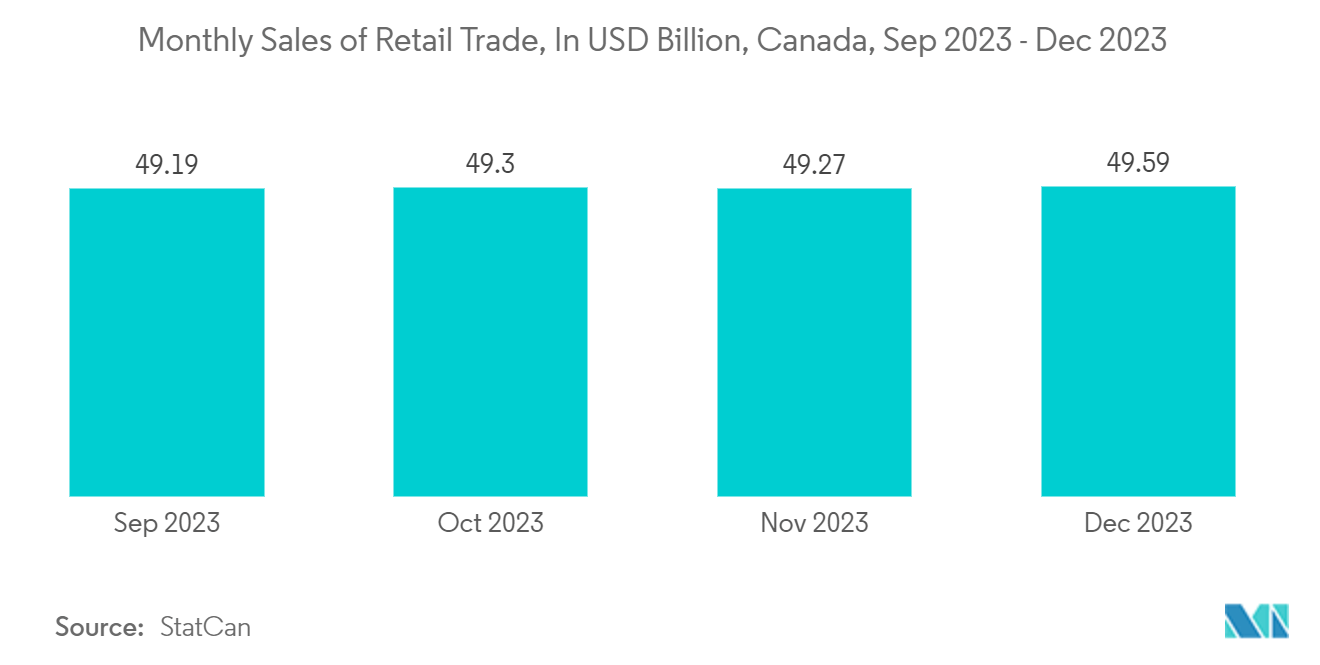
The Beverages Segment is Expected to Record Market Growth
- With the growing popularity of organic drinks, beverage companies will seek innovative and attractive packaging solutions to differentiate their products. Plastic bottle manufacturers offer opportunities for customized designs, shapes, and sizes to enhance brand visibility and appeal to consumers. According to Agriculture and Agri-Food Canada, in 2021, retail sales of organic drinks reached approximately USD 557.6 million; this is expected to increase to around USD 735.8 million by 2025.
- Many consumers who choose organic products also prioritize environmental sustainability. Beverage companies may choose plastic bottle options that incorporate eco-friendly materials or have a lower environmental footprint than traditional packaging alternatives. This can include utilizing recyclable or biodegradable plastics in the packaging, contributing to a more sustainable supply chain.
- The growth in Canada's export market for non-alcoholic beverages can drive expansion and innovations in the market, creating opportunities for economic growth and industry advancement. The US Department of Agriculture reported that Canada's export market for non-alcoholic beverages (excluding juices) reached approximately USD 1.46 billion in 2023, increasing from around USD 1.19 billion in 2020.
- A strong beverage export market can open international trade opportunities for Canadian packaging manufacturers. As beverage producers expand into new markets, they will require reliable packaging suppliers, leading to increased plastic bottle packaging materials and machinery exports.
- According to the FCC (Farm Credit Canada), the beverage and food manufacturing sector experienced growth. As new products like protein, energy, and low-alcohol options hit the market, the beverages segment is expected to surpass overall food and beverage unit sales in 2024.
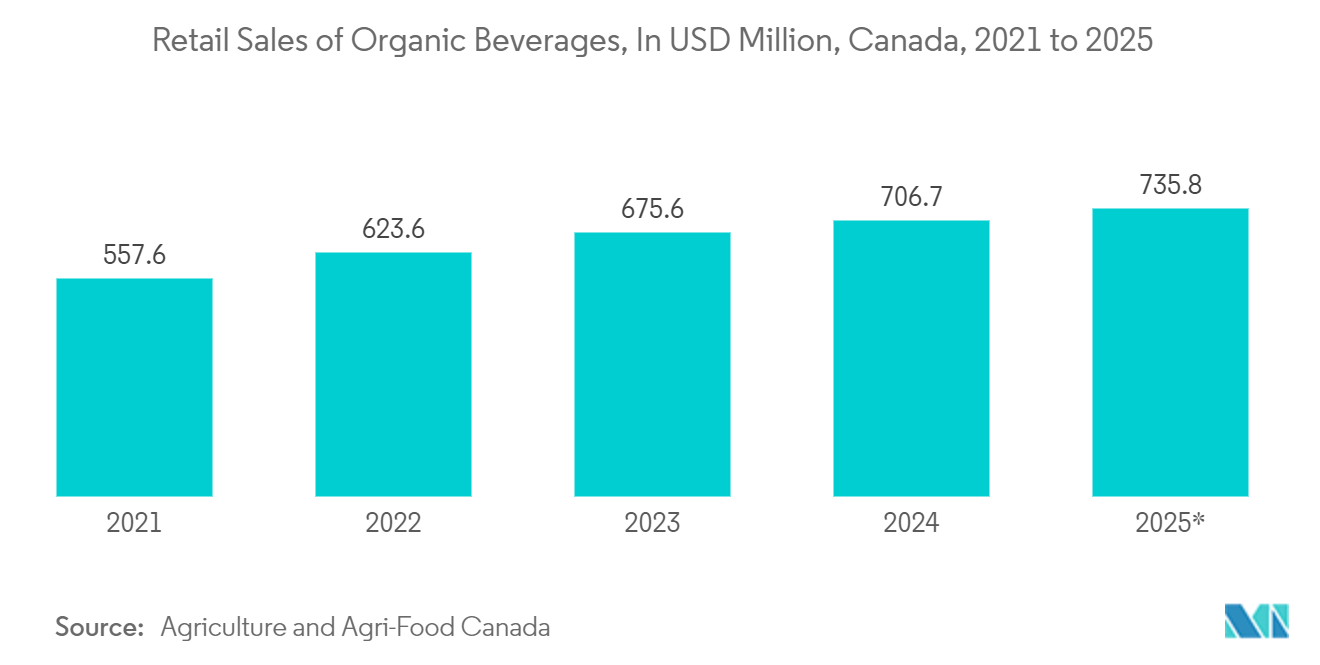
Competitive Landscape
The Canadian plastic bottles market is fragmented with the presence of global and domestic players such as Silgan Holdings Inc., Amcor Group GmbH, Berry Global Inc., TricorBraun Canada, and Bramalea Bottle Inc. Companies are focused on expanding their business through innovations, collaborations, investments, and mergers, among others.
- April 2024: Amcor, a global frontrunner in crafting responsible packaging solutions, is debuting a one-liter polyethylene terephthalate (PET) bottle for carbonated soft drinks (CSDs), produced entirely from 100% post-consumer recycled (PCR) materials. This pioneering stock option empowers customers in their sustainability endeavors. Continuing its legacy of packaging innovation, Amcor Rigid Packaging (ARP) integrated the one-liter CSD 100% PCR bottle into its portfolio of eco-conscious packaging solutions.
- October 2023: TricorBraun, a global player in packaging, sealed a partnership with AFA Dispensing Group. AFA boasts a technology portfolio that features OpUs pre-compression sprayers, Flair's innovative double-layer bottle technology, and the next-generation Flairosol spray solutions, an advanced alternative to traditional aerosols. This collaboration positioned TricorBraun as the primary distributor for AFA's state-of-the-art, sustainable, and rechargeable Flairosol spray bottle technology in Canada and other countries such as the United States.
Canada Plastic Bottles Industry Leaders
-
Silgan Holdings, Inc.
-
Amcor Group GmbH
-
Berry Global, Inc.
-
TricorBraun Canada
-
Bramalea Bottle INC.
- *Disclaimer: Major Players sorted in no particular order
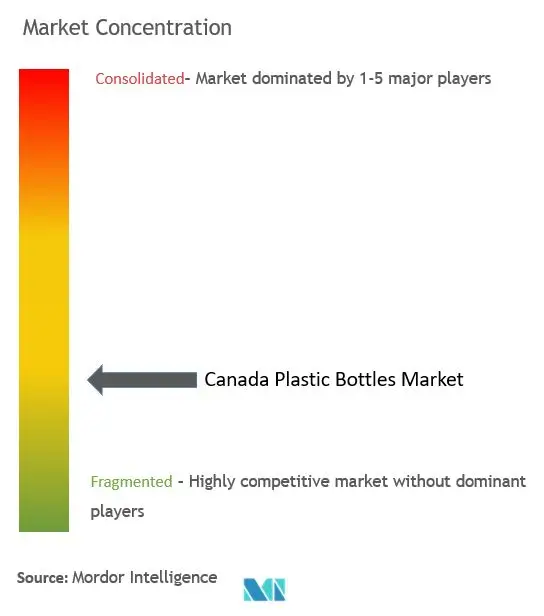
Recent Industry Developments
- July 2024: Football legend Lionel Messi launched a hydration beverage, Más+, in Canada. Developed in collaboration with the Mark Anthony Group flavor innovators, Más+ is a blend of electrolytes, vitamins, and minerals. Más+ is available in four flavors at 7-Eleven stores. Each 500 ml bottle contains ten calories and 1 g of cane sugar.
- October 2023: The Coca‑Cola Company launched recycled bottles, aiming to ensure that all 500 ml sparkling beverage bottles sold in Canada are crafted from 100% recycled plastic in 2024. This initiative will pioneer Coca-Cola in launching multiple sparkling beverages in 100% recycled plastic bottles throughout Canada. Bottles crafted from 100% recycled plastic play a pivotal role in fostering a circular economy for plastic packaging. Recycling involves cleaning, sorting, and grinding the material (PET) into small flakes, which serve as raw material for producing new bottles.
Canada Plastic Bottles Market Report Scope
The scope of the study characterizes the plastic bottle market based on the raw materials of the product, including PP, PE, PET, and other raw materials, which are used across various end-user industries, such as food, pharmaceuticals, beverages, cosmetics, and toiletries. The study also examines underlying growth influencers and significant market vendors, which support market estimates and growth rates throughout the forecast period. The market estimates and projections are based on the base year, using both top-down and bottom-up approaches.
The Canadian plastic bottles market is segmented by resin (polyethylene (PE), polyethylene terephthalate (PET), polypropylene (PP), and other resins) and end-use industries (food, beverages (bottled water, carbonated soft drinks, alcoholic beverages, juices and energy drinks, and other beverages (powdered and dairy-based beverages)), pharmaceuticals, personal care and toiletries, household chemicals, paints and coatings, and other end-use industries). The market sizing and forecasts are provided in terms of value (USD) and volume (tonnes) for all the above segments.
| Polyethylene (PE) |
| Polyethylene Terephthalate (PET) |
| Polypropylene (PP) |
| Other Resins (Polystyrene, PVC, Polycarbonate, etc.) |
| Food | |
| Beverage | Bottled Water |
| Carbonated Soft Drinks | |
| Alcoholic Beverages | |
| Juices & Energy Drinks | |
| Other Beverages | |
| Pharmaceuticals | |
| Personal Care & Toiletries | |
| Industrial | |
| Household Chemicals | |
| Paints & Coatings | |
| Other End-use Industries |
| By Resin | Polyethylene (PE) | |
| Polyethylene Terephthalate (PET) | ||
| Polypropylene (PP) | ||
| Other Resins (Polystyrene, PVC, Polycarbonate, etc.) | ||
| By End-use Industries | Food | |
| Beverage | Bottled Water | |
| Carbonated Soft Drinks | ||
| Alcoholic Beverages | ||
| Juices & Energy Drinks | ||
| Other Beverages | ||
| Pharmaceuticals | ||
| Personal Care & Toiletries | ||
| Industrial | ||
| Household Chemicals | ||
| Paints & Coatings | ||
| Other End-use Industries | ||
Key Questions Answered in the Report
How big is the Canada Plastic Bottles Market?
The Canada Plastic Bottles Market size is worth USD 0.64 billion in 2025, growing at an 4.82% CAGR and is forecast to hit USD 0.81 billion by 2030.
What is the current Canada Plastic Bottles Market size?
In 2025, the Canada Plastic Bottles Market size is expected to reach USD 0.64 billion.
Who are the key players in Canada Plastic Bottles Market?
Silgan Holdings, Inc., Amcor Group GmbH, Berry Global, Inc., TricorBraun Canada and Bramalea Bottle INC. are the major companies operating in the Canada Plastic Bottles Market.
What years does this Canada Plastic Bottles Market cover, and what was the market size in 2024?
In 2024, the Canada Plastic Bottles Market size was estimated at USD 0.61 billion. The report covers the Canada Plastic Bottles Market historical market size for years: 2019, 2020, 2021, 2022, 2023 and 2024. The report also forecasts the Canada Plastic Bottles Market size for years: 2025, 2026, 2027, 2028, 2029 and 2030.
Page last updated on:
Canada Plastic Bottles Market Report
Statistics for the 2025 Canada Plastic Bottles market share, size and revenue growth rate, created by Mordor Intelligence™ Industry Reports. Canada Plastic Bottles analysis includes a market forecast outlook for 2025 to 2030 and historical overview. Get a sample of this industry analysis as a free report PDF download.
